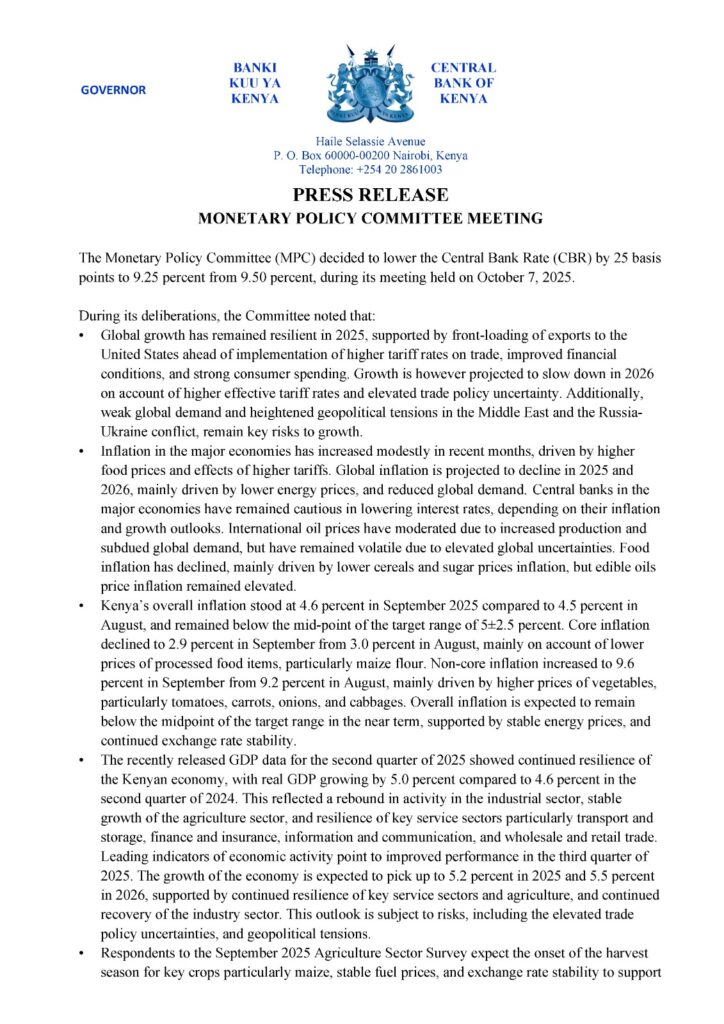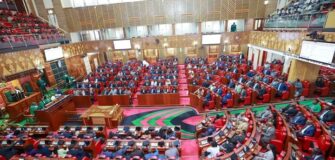Good News for Borrowers as Central Bank Lowers CBR by 25 Basis
Good News for Borrowers as Central Bank Lowers CBR by 25 Basis
Share
The Monetary Policy Committee (MPC) has decided to lower the Central Bank Rate (CBR) by 25 basis points to 9.25 percent from 9.50 percent, during its meeting held on October 7, 2025.
During its deliberations, the Committee noted that the global growth has remained resilient in 2025.
This has been supported by front-loading of exports to the United States ahead of implementation of higher tariff rates on trade, improved financial conditions, and strong consumer spending.
Growth is however projected to slow down in 2026 on account of higher effective tariff rates and elevated trade policy uncertainty.
Additionally, weak global demand and heightened geopolitical tensions in the Middle East and the Russia-Ukraine conflict, remain key risks to growth.
Global Inflation
Inflation in the major economies has increased modestly in recent months, driven by higher food prices and effects of higher tariffs.
Global inflation is projected to decline in 2025 and 2026, mainly driven by lower energy prices, and reduced global demand.
Central banks in the major economies have remained cautious in lowering interest rates, depending on their inflation and growth outlooks.
International oil prices have moderated due to increased production and subdued global demand, but have remained volatile due to elevated global uncertainties.
Food inflation has declined, mainly driven by lower cereals and sugar prices inflation, but edible oils price inflation remained elevated.
Kenya’s Overall Inflation
Kenya’s overall inflation stood at 4.6 percent in September 2025 compared to 4.5 percent in August, and remained below the mid-point of the target range of 5+2.5 percent.
Core inflation declined to 2.9 percent in September from 3.0 percent in August, mainly on account of lower prices of processed food items, particularly maize flour.
Non-core inflation increased to 9.6 percent in September from 9.2 percent in August, mainly driven by higher prices of vegetables, particularly tomatoes, carrots, onions, and cabbages.
Overall inflation is expected to remain below the midpoint of the target range in the near term, supported by stable energy prices, and continued exchange rate stability.
GDP
The recently released GDP data for the second quarter of 2025 showed continued resilience of the Kenyan economy, with real GDP growing by 5.0 percent compared to 4.6 percent in the second quarter of 2024.
This reflected a rebound in activity in the industrial sector, stable growth of the agriculture sector, and resilience of key service sectors particularly transport and storage, finance and insurance, information and communication, and wholesale and retail trade.
Leading indicators of economic activity point to improved performance in the third quarter of 2025.
The growth of the economy is expected to pick up to 5.2 percent in 2025 and 5.5 percent in 2026, supported by continued resilience of key service sectors and agriculture, and continued recovery of the industry sector.
This outlook is subject to risks, including the elevated trade policy uncertainties, and geopolitical tensions.

Central Bank of Kenya statement after the MPC meeting on October 7, 2025. PHOTO/CBK.
You Might also Like















